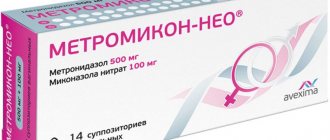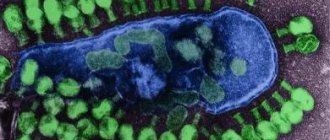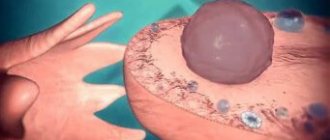Indications for the use of tampons in gynecology
Tampons with Dimexide are used in gynecology to treat:
- Erosion is a disorder of the mucous membrane of the cervix (cervix). A benign pathological process that comes in different types. In some cases it can lead to cancer.
- Candidiasis (thrush), that is, an inflammatory disease caused by fungi of the genus Candida.
- Colpitis or vaginitis. This is an inflammatory lesion of the vaginal mucosa caused by various microorganisms.
- Cervicitis is an inflammatory process of the cervical mucosa. It is divided into two types: exocervicitis (affects the exocervix - the vaginal segment of the cervix) and endocervicitis (inflammation of the endocervix - the inner lining of the cervical canal).
- Endometriosis. With this disease, endometrial cells appear in atypical places. For example: in the ovaries, in the fallopian tubes, on the bladder, as well as on other organs and tissues.
- Adhesive processes. This is a pathological condition in which cords form, causing pain and disruption of the internal organs.
Dimexide is indicated for restoring the body after surgery, childbirth, and irradiation of malignant neoplasms. In addition, the drug is used as an adjuvant that enhances the effect of other drugs.
Tampons with Dimexide should be used only as prescribed by a doctor. The dosage, duration of treatment and how long you need to keep the tampon in place depend on the disease, the age of the patient, as well as the individual characteristics of the body.
The course of treatment usually ranges from 1 to 2 weeks, 2 times a day or at night. Tampons soaked in medication should be placed deep into the vagina and left for several hours.
Action and effectiveness of the drug
The demand for Dimexide is explained by the high permeability of DMSO (dimethyl sulfoxide) through the mucous membranes, skin, and cell walls of microorganisms into the bloodstream and the increased permeability of additional substances that are diluted with it.
Dimexide is a drug with analgesic and anti-inflammatory effects.
The molecules of the active substance enter the blood within five minutes after using the drug. Their maximum concentration is observed after 2–7 hours. Then it gradually decreases over 1.5–3 days.
When Dimexide is applied to an area of skin, a characteristic smell of garlic appears.
The characteristics of the drug also include the ability to dissolve chemicals with different structures:
- antibiotics;
- alkaloids;
- hormones;
- salt;
- vitamins;
- cytostatic drugs.
Dimexide not only accelerates their penetration into the bloodstream. He:
- does not affect their properties and composition;
- reduces the cost of treatment because it dilutes expensive medications;
- reduces the list of unwanted reactions of the body, as it reduces the concentration of the main substance.
When applied (application) to the skin or mucous membranes, Dimexide is absorbed in full (this does not apply to hair, tooth enamel, and nail cells).
The active substance is excreted from the body through the gastrointestinal tract (gastrointestinal tract) or urine. The drug may be released through the skin or lungs, which is necessarily accompanied by a garlicky odor.
With long-term use, no accumulation of dimexide in the body was observed.
Technique for making a tampon with Dimexide
Tampons with Dimexide are prescribed by the doctor after collecting anamnesis, tests and diagnosis. Prescribing treatment yourself can harm your health. The gynecologist will tell you what proportions of the medicine are needed, how to make a cotton swab, and how long it should be inserted into the vagina.
A high concentration of Dimexide will cause a burn on the mucous membrane; it must be diluted. For different diseases, different ratios of water and solution are used. Typically an aqueous concentrate with 10-30% medication is used. The water must be distilled or boiled. The finished solution has the smell of garlic.
It must be diluted with water as follows:
- to obtain a 10% solution you need 18 ml of water and 2 ml of Dimexide;
- for a 30% solution – 6 ml of water and 14 ml of the drug.
Pharmacy tampons will not work. They are created to absorb moisture, and medicinal ones are designed to introduce a solution. Making a tampon yourself is easy. You will need:
- about 20 cm of sterile bandage;
- a little sterile cotton wool.
When making tampons, it is better to wear sterile gloves. If they are not there, you must wash your hands thoroughly to avoid introducing infections and microorganisms. Form a small ball or cylinder out of cotton wool, about 3 cm in diameter. The cotton wool is placed in the center of the bandage strip, then two tight knots are tightened. If you do not tie it tightly, the tampon can greatly increase in size from the medication and its insertion will be problematic. There is no need to cut off the tails of the bandage; they will help remove the medicine. It is important that there are no threads on the surface of the package; they need to be cut or wrapped inside.
The finished tampon is dipped in the medicine and inserted into the vagina. Most often, a course of medication is prescribed for several days, morning and evening or at night. Can be stored in a glass container with a tightly closed lid. It is recommended to prepare the solution before use.
Forms of release and composition of Dimexide
The main component of the drug is dimethyl sulfoxide, which has an antimicrobial and anesthetic effect. Its concentration and list of excipients depend on the form of release:
- Liquid concentrate 99%. The product is in dark bottles of different volumes - from 40 to 120 ml. Used to make a solution.
- Gel 25 or 50%:
- purified water;
- carmellose sodium;
- nipagin;
- nipazole
Dimexide gel for external use is available in convenient 30 g tubes
- Suppositories with propolis 20%:
- cacao butter;
- propolis.
The substance dimethyl sulfoxide is found in Propolis-D suppositories. Suppositories consisting of Dimexide alone are not produced.
The product has a yellowish tint and a strong garlic odor.
With Vishnevsky ointment
Tampons with Dimexide and Vishnevsky ointment are effective for inflammatory processes in the vagina, ovaries, cervix and appendages. The ointment is used for recovery after operations, as it activates regeneration at the cellular level, destroys pathogenic microflora, and normalizes the vaginal environment. It has a resolving effect on neoplasms and cysts, eliminates obstruction of the fallopian tubes. Use is prohibited in case of acute infection, kidney disease and individual intolerance to the components.
How it works
The anti-inflammatory effect is exerted by suppressing active substances that cause inflammation in the body.
Significantly helps reduce swelling of tissues and discharge from the genital organs. It also has an antimicrobial effect as it perfectly penetrates bacterial cells. Light anesthetic effect, reduces discomfort in the genital area.
Dimexide is absorbed into tissues as deeply as possible, and therefore its use is possible in combination with other medicinal substances. Most often it is Lidaza, Vishnevsky ointment, aloe. Because of this unique ability of Dimexide, the substances instantly act on inflammation, which helps rapid recovery. If you need to quickly relieve pain, tampons soaked in Novocaine and Dimexide are prescribed. If it is a bacterial infection, antibiotics in the form of injection solutions will come to the aid of the remedy.
Contraindications to treatment with Dimexide
Dimexide has a number of contraindications. The drug is strictly prohibited for children under 12 years of age, elderly people, pregnant and breastfeeding women. It can cause premature birth or miscarriage. The drug can be passed on to the baby from the mother through milk, negatively affecting health. Dimexide is also prohibited:
- for disorders of the liver and kidneys;
- for strokes;
- in case of diseases of the cardiovascular system;
- for ophthalmological problems.
The main component can cause an allergic reaction; before using the drug, it is necessary to conduct a sensitivity test to Dimexide. To do this, apply a small dose of the drug to the arm in the elbow area. The appearance of itching and redness indicates the presence of individual intolerance. It is prohibited to use the product.
Do not use a tampon with Dimexide during menstruation.
Reviews
There are different reviews about the use of Dimexide solution for inflammation of the appendages. Almost all patients who had to use the medication speak about it in a positive way. After just a few days of regular use of tampons, the disturbing signs of inflammation disappeared. There is no way to check the information for accuracy.
Despite the rapid effect, doctors do not recommend interrupting treatment.
There are groups of patients who categorically do not want to be treated in this way. Having read about the terrible consequences of Dimexide, they consider the drug life-threatening. Indeed, in its pure form the medication can worsen the patient’s condition.
Whether to use Dimexide for inflammation of the appendages or not is a personal matter for each woman. Before self-medicating, it is better to consult a doctor and find out what causes adnexitis.
Possible side effects
When using Dimexide as prescribed by a doctor, following all recommendations, it will not cause harm to the body. Exceeding the dose or using the drug for too long can cause a number of side effects. Among them:
- Dizziness.
- Nausea, vomiting, diarrhea, or constipation.
- Insomnia.
- Contact dermatitis, increased pigmentation of the skin.
- Dry skin.
- Narrowing of the bronchi, shortness of breath.
- Persistent odor of garlic from sweat, saliva and urine.
If symptoms occur, you should immediately stop using the drug.
It should be remembered that one of the properties of Dimexide is to enhance the healing and toxic properties of other drugs on the body. Therefore, before use, you should consult a gynecologist and be careful when using the drug.
Vaginal side effects may occur. Swelling, burning, itching, and bleeding indicate that you need to stop using the drug. Sexual activity is prohibited during treatment.
Overdose is possible. Symptoms include an allergic reaction, a burn of the mucous membrane.
Be careful when preparing and storing the solution. Be sure to read the instructions before use.
Dimexide - basic information
Dimexide is a clear or light yellow liquid with a slight aroma similar to the smell of garlic. The concentrate consists of dimethyl sulfoxide. The solution is usually packaged in bottles of 50 and 100 ml.
The drug has the following properties:
- Anti-inflammatory effect. Dimethyl sulfoxide inhibits the production of prostaglandins, which provoke inflammation. As a result, redness, swelling, itching, and burning disappear.
- Analgesic effect. Blocks the sensitivity of nerve endings, as a result, mild pain disappears, or the severity of severe pain decreases.
- Disinfecting effect. Destroys harmful microorganisms on damaged mucous membranes of the genital organs.
- Thrombolytic effect. Dissolves fibrin plaque in the source of infection, accelerates the healing of damaged tissue.
If side effects occur, you should consult a gynecologist.
Doctors' opinion
Doctors have different opinions regarding the use of tampons with Dimexide, because they may not be suitable for every woman. Before using the drug, the patient must undergo tests and undergo a sensitivity test.
Tampons with Dimexide are used as an additional method of treatment. As an independent remedy, they are less effective.
Opinion of gynecologists
Gynecologists have a positive attitude towards treatment with tampons with Dimexide (including in combination with other drugs), pointing out its effectiveness and low cost.
To avoid burns, doctors recommend not increasing the prescribed concentration of the solution.
The patient's condition improves after just a few days of using medicinal tampons. Sometimes, after a course of treatment, gynecologists recommend that patients put suppositories to restore the microflora.
It is preferable to use tampons with Dimexide in combination with other drugs.
During the course of treatment, it is recommended to use panty liners.











